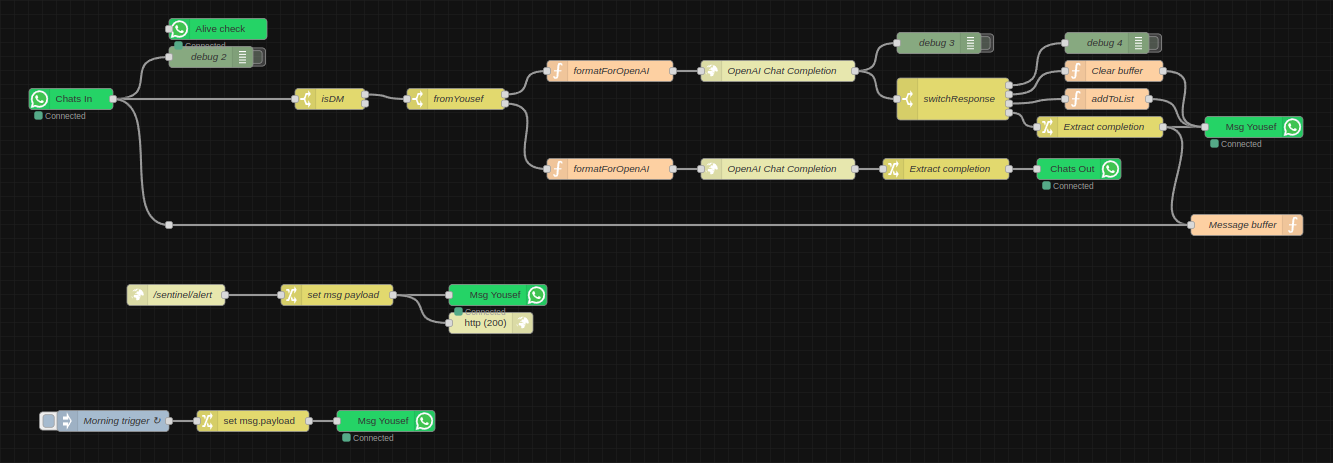Sentinel
Sentinel started off as an AI chat assistant on top of my smart home infrastructure. It has since evolved into a general purpose personal assistant that can also talk to others on my behalf through WhatsApp.
Amar Memoranda > Sentinel
Yousef AmarLog
Sentinel gets a brain and listens to the internet
Sentinel, my AI personal assistant has evolved a bit since I last wrote about him. I realised I hadn't written about that project in a while when it came up in conversation and the latest reference I had was from ages ago. The node-red logic looks like this now:

- Every morning he sends me a message (in the future this will be a status report summary). The goal of this was to mainly make sure the WhatsApp integration still works, since at the time it would crap out every once in a while and I wouldn't realise.
- I have an endpoint for arbitrary messages, which is simply a URL with a text GET parameter. I've sprinkled these around various projects, as it helps to have certain kind of monitoring straight to my chats.
- He's plugged in to GPT-4-turbo now, so I usually just ask him questions instead of going all the way to ChatGPT. He can remember previous messages, until I explicitly ask him to forget. This is the equivalent of "New Chat" on ChatGPT and is controlled with the functions API via natural language, like the list-adder function which I already had before ("add Harry Potter to my movies list").

As he's diverged from simply being an interface to my smart home stuff, as well as amarbot which is meant to replace me, I decided to start a new project log just for Sentinel-related posts.
Edit: this post inspired me to write more at length about chat as an interface here.
Sentinel: my AI right hand
I mentioned recently that I've been using OpenAI's new functions API in the context of personal automation, which is something I've explored before without the API. The idea is that this tech can short-circuit going from a natural language command, to an actuation, with nothing else needed in the middle.
The natural language command can come from speech, or text chat, but almost universally, we're using conversation as an interface, which is probably the most natural medium for complex human interaction. I decided to use chat in the first instance.
Introducing: Sentinel, the custodian of Sanctum.

No longer does Sanctum process commands directly, but rather is under the purview of Sentinel. If I get early access to Lakera (the creators of Gandalf), he would also certainly make my setup far more secure than it currently is.
I repurposed the WhatsApp number that originally belonged to Amarbot. Why WhatsApp rather than Matrix? So others can more easily message him -- he's not just my direct assistant, but like a personal secretary too, so e.g. people can ask him for info if/when I'm busy. The downside is that he can't hang out with the other Matrix bots in my Neurodrome channel.
A set of WhatsApp nodes for Node-RED were recently published that behave similarly to the main Matrix bridge for WhatsApp, without all the extra Matrix stuff in the way, so I used that to connect Sentinel to my existing setup directly. The flow so far looks like this:

The two main branches are for messages that are either from me, or from others. When they're from others, their name and relationship to me are injected into the prompt (this is currently just a huge array that I hard-coded manually into the function node). When it's me, the prompt is given a set of functions that it can invoke.
If it decides that a function should be invoked, the switchResponse node redirects the message to the right place. So far, there are only three possible outcomes: (1) doing nothing, (2) adding information to a list, and (3) responding normally like ChatGPT. I therefore sometimes use Sentinel as a quicker way to ask ChatGPT one-shot questions.
The addToList function is defined like this:
{
name: "addToList",
description: "Adds a string to a list",
parameters: {
type: "object",
properties: {
text: {
type: "string",
description: "The item to add to a list",
},
listName: {
type: "string",
description: "The name of the list to which the item should be added",
enum: [
"movies",
"books",
"groceries",
]
},
},
required: ["text", "listName"],
},
}I don't actually have a groceries list, but for the other two (movies and books), my current workflow for noting down a movie to watch or a book to read is usually opening the Obsidian app on my phone and actually adding a bullet point to a text file note. This is hardly as smooth as texting Sentinel "Add Succession to my movies list". Of course, Sentinel is quite smart, so I could also say "I want to watch the first Harry Potter movie" and he responds "Added "Harry Potter and the Sorcerer's Stone" to the movies list!".
The actual code for adding these items to my lists is by literally appending a bullet point to their respective files (I have endpoints for this) which are synced to all my devices via the excellent Syncthing. In the future, I could probably make this fancier, e.g. query information about the movie/book and include a poster/cover and metadata, and also potentially publish these lists.